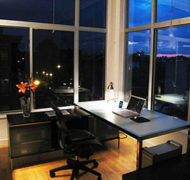Transition to Telecommuting
Blog / Produced by The High Calling
In the early years, my husband’s commute wasn’t bad. Philippe could get to the office in about 25 minutes, even during peak rush hour. Later, he switched jobs and joined a long line of traffic inching into the city center. That commute? Just under an hour. His supervisor often insisted he work late, so by the time Philippe packed up and arrived home, it was close to bedtime. We tried to accommodate his schedule by shifting to a later family dinnertime, but often ate without him, and our youngest would sometimes go to bed without saying goodnight to his Papa.
During that era, Philippe, an avid runner, struggled to squeeze in a short run before or after work. Eventually he gave up on exercise during the workweek, even though his cholesterol was creeping up. Philippe also volunteered as a coach for our recreational soccer league, but would have to text his assistant coach to sub for him when the boss told Philippe in no uncertain terms he must stay late. I saw the strain in Philippe’s face and felt the stress in his voice.
Unexpectedly, Philippe’s boss resigned a few months ago. Philippe began reporting to a new supervisor, resulting in a drastically different work situation. Now his commute takes approximately 45 seconds—the time it takes to pour a second cup of coffee, walk downstairs, and power up his computer.
My husband joined the ranks of early telecommuters, also known as work-from-home (WFH) employees.
His company embraced this WFH model, hiring a decentralized workforce, especially to build their project management group. Philippe and his coworkers live all over the United States, with his new supervisor located in California and colleagues in New York City, Arizona, Indiana, Colorado, Connecticut, and Virginia.
At first, after decades of dressing in business attire and commuting to a corporate office, staying at home felt strange. In fact, Philippe continued to drive down to the office once or twice a week, but with the old boss gone, the office is quiet and empty except for Bruce, who works in the cubicle next to Philippe’s. He enjoyed Bruce’s company, but their work doesn’t overlap much, so being on-site offers Philippe few advantages. Eventually, Philippe stopped bothering with the drive downtown. He set up his office in our basement. We gave him a desk lamp for Christmas.
Marissa Mayer, CEO of Yahoo, had her top human relations executive send a memo to employees declaring that their WFH days are numbered. Starting in June, they are to report to the office again. The goal? Greater efficiency and a more unified workforce.
Discussions and debates ensued regarding the pros and cons of work-from-home versus work-from-office for both employees and employers. Certain industries and positions within companies—not to mention individual personalities and their work styles—lend themselves better than others to a work-from-home setup. Some argue that employees will slack off at home and need to be in an office to be accountable to on-site supervisors; others concerned about work-family/work-life balance argue that WFH employees would put in too much time and blur the line between work hours and home life.
I can attest that Philippe remains focused and diligent, leading virtual meetings from his home office just exactly as he did from his cubicle downtown. Speed and quality don’t seem sacrificed in the least. He takes a brief lunch break before heading back to his desk. In the mornings, he can head out on a jog, come back for a shower and be at his computer at least half an hour before he would have made it downtown.
Based on his performance review, Philippe’s supervisor seems pleased. She asked him to continue a meeting the other night so that he worked until about 7:30 p.m., but as soon as he was done, he didn’t face that hour-long commute. Instead, he powered down his laptop, clicked off his desk lamp, and ran up the stairs.
He opened the basement door and greeted us all with a big, relaxed smile.
“How was work today?” I asked, just as if he’d gone to an office.
“Intense,” he replied, “but productive.”
Then he sat down and joined us for dinner.









